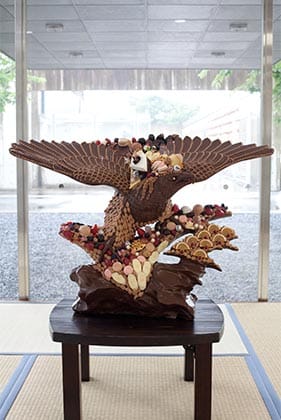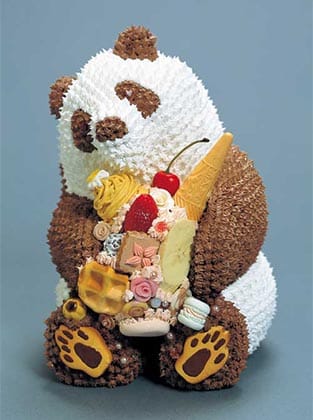Japanese artist Osamu Watanabe works with dekoden, a popular Japanese art technique that operates much like BeDazzlers do, where object surfaces are covered with glittering beads. However, instead of glittering beads, dekoden covers surfaces with fake whipped cream and plastic candies, creating objects that appear good enough to eat.
In a series of works titled Life, Watanabe employs dekoden to cover ceramic sculptures of animals of all sorts. He makes everything, from domesticated animals like cats and dogs to endangered wildlife like pandas, giraffes, and eagles.

Watanabe’s pieces question the relationships humans forge with these animals. These candied animals bring to the forefront of the viewer's consciousness how humans objectify animal life in the consumption choices they make, reflecting the United Nations Sustainable Development Goal of Responsible Consumption and Production.

Take, for example, his piece, Sweet Panda. The panda here is coated with what can only be read as vanilla and chocolate buttercream. It is aptly constructed in a mouth-watering way, to the point where viewers feel like they could swipe at it with their fingers and taste its sweetness and rich creaminess. Between the panda’s paws are equally delicious-looking desserts, ice creams, waffles, and macarons that the sweet panda is barely holding on to.
In the wild, the Giant Panda is classified as a vulnerable species, as only six wild populations have more than 100 individuals. According to World Wild Life, human consumption activities such as agriculture, logging, and infrastructure development pose a big threat to these panda populations. Their habitats have been allowed to persist at elevations higher than productive agricultural land, but with increased demand for agriculture, the agricultural value of the panda’s current habitat also increases.
In the future, activities like growing crops and grazing livestock may further encroach on their habitat, making them lose their homes and the bamboo crops necessary for their diet. These are agricultural products that may as well be processed into the sweets that Watanabe’s Sweet Panda is holding on to.
Climate change also affects bamboo growth rate, the very plant that makes up almost 90 percent of a panda’s diet. Hence, as Watanabe’s work recalls, there is a need for viewers to rethink how their consumption choices are affecting the lives of pandas.
Another piece Watanabe has created is a sugar-coated grizzly bear with a taiyaki, a fish-shaped cake, in its mouth. According to the United States Geological Survey, bear populations and food sources are largely impacted by human life, mainly due to the conversion of wild lands and waterways for intensive human use.
